#antiaircraft guns
Explore tagged Tumblr posts
Photo
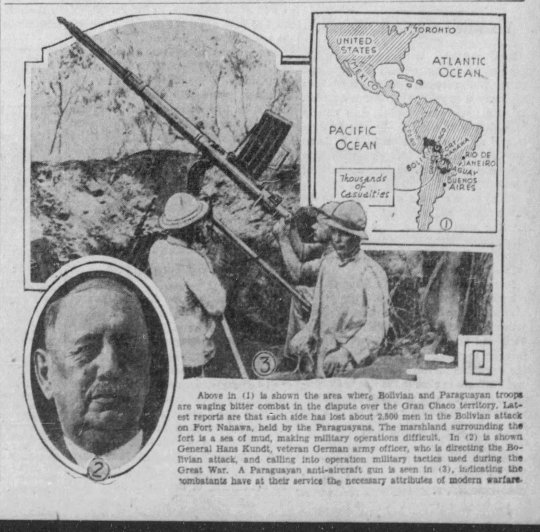
“Above in (1) to shown the area where Bolivian and Paraguayan troops are waging bitter combat in the dispute over the Gran Chaco territory. Latest reports are that each side has lost about 2,000 men in the Bolivian attack on Fort Nanawa, held by the Paraguayans. The marshland surrounding the fort is a sea of mud making military operations difficult. In (2) is shown General Hans Kundt, veteran German army officer, who is directing the Bolivian attack and calling into operation military tactics used during the Great War. A Paraguayan anti-aircraft gun is seen in (1) indicating the combatants have at their service the necessary attributes of modern warfare.”
- from the Kingston Whig-Standard. January 30, 1933. Page 3.
#gran chaco#chaco war#guerra del chaco#paraguay#bolivia#paraguayan history#bolivian history#fort nanawa#german military advisor#world war 1#interwar period#ejército paraguayo#antiaircraft guns#aa guns#cháko Ñorairõ
4 notes
·
View notes
Text
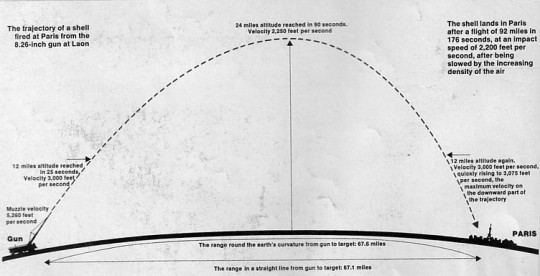
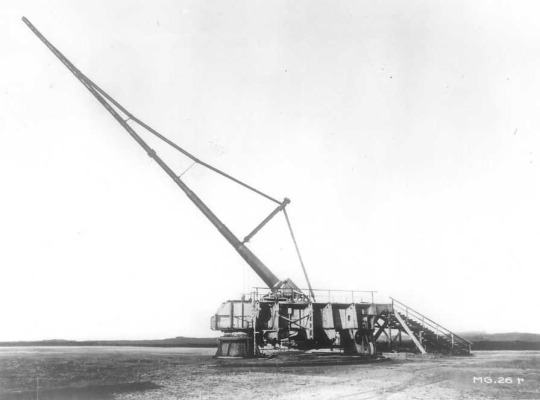
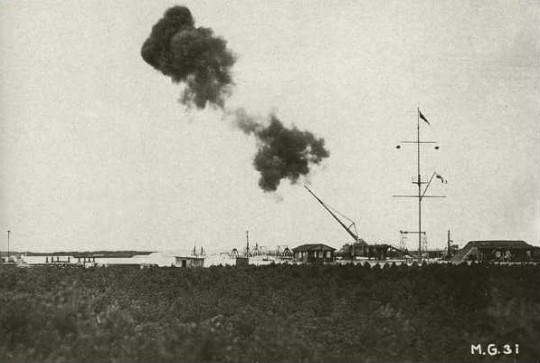
The Paris Gun
The Krupp arms-making dynasty was founded in Essen upon the fortune amassed by Arndt Krupp, who settled in that city in 1587. His son Anton expanded the family’s endeavors into making firearms during the Thirty Years’ War of 1618-1648, and the family progressively expanded its operations over the ensuing decades. In 1811, Friedrich Krupp (1787-1826) established a steel casting facility, and, although he successfully began casting steel in 1816, he expended considerable funds in the process. His son, Alfried (1812- 1887), continued his father’s work and eventually re-established the family fortune. By its nature steel was very difficult to cast, and internal faults were often impossible to detect through existing testing procedures. Defective cast steel pieces were also much more dangerous to crews than iron cannons, as the softer iron tended to split or burst with less energy than the harder steel, which more often ruptured with deadly violence. The Krupp firm’s success in casting steel was considered one of the major metallurgical achievements of its day.
Beginning in 1844, Alfried Krupp began experimenting in machining guns from solid cast steel blanks and in 1847 produced his first steel cannon. That same year he presented a steel gun to the King of Prussia, Frederick Wilhelm IV (1795-1861)-an act of entrepreneurial generosity that later won an order for 300 field guns. He went on to display a 6-pounder muzzleloading gun at the Great Exhibition of 1851 and began experiments in developing breechloading weapons. In 1856, Krupp introduced a 90mm field gun fitted with a transverse sliding breechblock that fit through a corresponding slot in the rear of the barrel.
Germany subsequently made the transition to rifled breechloaders during the 1860s, a move that gave it a distinct artillery advantage during the 1870-1871 Franco-Prussian War. Shortly after the war it adopted 78.5mm guns for its horse artillery and 88mm pieces for field use. The logistical difficulties associated with supplying two sizes of ammunition in the field and recent advances in metallurgy and gun design then led to the Model 73/88 system, which used the 88mm caliber for both horse artillery and field use and the later Model 73/91 system, utilizing nickel steel barrels. The Model 73/91 was finally superseded by Germany’s answer to the French 75-the Model 96 or Feldkanone 96 neur Art.
The development of specialized antiaircraft artillery also intensified during the war. The first documented use of antiaircraft artillery occurred as early as the siege of Paris during the Franco-Prussian War in 1870. At Paris, the Prussian commander von Moltke ordered weapons from Krupp in order to shoot down balloons in which the French were trying to sail over the Prussian lines. Krupp eventually delivered a number of single-shot, caliber 1-inch rifles that were mounted on pedestals bolted to the beds of two-horse wagons; they theoretically could follow the balloons on the ground while maintaining a steady firing rate. The Krupp pieces were relatively ineffective, yet at least one French balloon was apparently downed by their fire.
The rapid proliferation of powered military aircraft at the turn of the century, however, spurred an equally dedicated effort to neutralize the threat of air attacks. During the 1909 Frankfurt International Exhibition, Krupp unveiled three antiaircraft guns in a bid to monopolize the emerging market. These included a caliber 65mm 9-pounder and a 75mm 12-pounder. Krupp claimed that the largest, a pedestal-mounted 105mm gun intended for shipboard use, achieved a maximum ceiling of 37,730 feet. The caliber 65mm gun had an 18,700-foot range, could elevate 75 degrees, and its carriage had unique hinged axles that allowed the wheels to be pivoted to a position perpendicular to their traveling position. With the trail spade acting as its axis, this arrangement enabled the crew to traverse the piece 360 degrees to track enemy aircraft. With a claimed maximum ceiling of 21,326 feet, the caliber 75mm gun was mounted on a truck bed, thus giving it a high degree of mobility. Not to be outdone, Erhardt, Krupp’s closest domestic competitor, also exhibited a 50mm quick-firing antiaircraft gun mounted in an armored car’s turret.
The period also witnessed considerable experimentation in antiaircraft shells and fuses. Krupp introduced a high-explosive shell for its 3-pounder equipped with a “smoke-trail” fuse, an early tracer round that both aided the crews in sighting and was an effective incendiary against the hydrogen-filled airships of the period.
During World War I the Germans continued to experiment in antiaircraft weaponry, beginning in 1914 with the 77mm Ballonen-AK. The Ballonen-AK was then, in turn, followed in 1915 by the 77mm Luftkanone, a basic 77mm field cannon barrel mounted on a rotating scaffolding. The more effective Krupp 88mm FlaK entered service in 1918 and eventually became the inspiration for the famous World War II German “Eighty-Eight.”
Popularly named after Alfred Krupp’s daughter, the 41.3-ton, 420mm “Big Bertha” had a horizontal sliding block and fired a 1,719-pound shell up to 10,253 yards. Big Bertha required five tractors to transport its components, and it had to be assembled on site. In conjunction with a number of Austrian Skoda 305mm howitzers, the L/14 was first used with devastating effect against Liege in August 1914; it saw other action on both the Western and Eastern fronts. Owing to its relatively short range and vulnerability to Allied fire, Big Bertha was obsolete by 1917. Another heavy piece, the 211mm Mörser was adopted in 1916. It weighed 14,727 pounds and fired a 250-pound shell up to 12,139 yards.
Designed by Krupp engineers and adopted in 1918, the Paris Gun used the basic 380mm Max railroad gun barrel fitted with a barrel liner and lengthened 20 feet. The 210mm Paris Gun weighed 1,653,470 pounds and mounted a 2,550-inch barrel with a horizontal sliding block. It fired a 264-pound shell up to 82 miles. Crewed by naval personnel, the Paris Gun was so powerful that it fired its shells into the stratosphere, where the thinner atmosphere exerted less resistance, allowing such long ranges. The stress on the bore, however, wore the barrel significantly, and each succeeding projectile had to have progressively larger driving bands and heavier powder charges to compensate for the increasing windage. Although hugely inefficient in the final analysis, the Paris Gun’s greatest value lay in its use as a propaganda tool rather than an artillery piece. Source
27 notes
·
View notes
Text




Ukrainian anti-drone technical firing at a Russian Shahed-136 over the eastern part of the country. This model, a UK-supplied Leyland DAF 45 attached to the 117th Mechanized Brigade, sports a bed-mounted ZU-23-2 antiaircraft gun.
31 notes
·
View notes
Text
It's probably not a good idea to fly anywhere near trigger-happy Russians. We remember how in 2014 pro-Putin Russian separatists in eastern Ukraine shot down Malaysia Airlines Flight MH17 killing 298 people.
This time an Azerbaijani airliner crashed after apparently being hit by Russian air defense fire.
An Azerbaijani lawmaker said there is a "very strong" possibility that the crash of a passenger jet earlier this week was caused by Russian air-defense systems on alert for Ukrainian drone attacks. Speculation has mounted that the Azerbaijan Airlines plane, which was headed from Baku to Grozny, the capital of Russia’s Chechnya region, may have been hit by an air-defense missile before crossing the Caspian Sea and crashing near Aqtau, Kazakhstan, killing 38 passengers and crew. Lawmaker Hikmat Babaoghlu told RFE/RL's Azerbaijani Service in an interview on December 27 that such an explanation is most likely "closest to the truth."
The Embraer E190 was on a regular flight from the Azerbaijani capital Baku to Grozny in Russia's Chechnya region.
Evidence points to a Pantsir-S self-propelled antiaircraft system built and operated by Russia.
White House spokesman John Kirby told reporters on December 27 that the United States has seen signs suggesting that the jet could have been hit by Russian air defense systems. U.S. experts "have seen some early indications that would certainly point to the possibility that this jet was brought down by Russian air defense systems," he said. Kirby added that Washington has “offered our assistance…should they need it" to the ongoing investigation being conducted by Azerbaijan and Kazakhstan. Evidence, yet to be corroborated by authorities, includes footage from inside the plane before the crash, images of the hole-pocked tail section after the crash, a survivor's comments, and accounts indicating there was a suspected drone attack around the time the plane apparently tried to land in Grozny. Reuters quoted an Azerbaijani source familiar with the investigation as saying results indicated the plane was hit by a Pantsir-S air-defense system, a self-propelled antiaircraft gun and missile system designed by Russia.
Air travel site AeroXplorer reported that the plane was denied permission by Russia to land on its territory after Russians damaged the plane.
The aircraft was not allowed to land at Russian airports despite the pilots' requests for an emergency landing and was told to fly across the Caspian Sea to Aktau in Kazakhstan. The aircraft's signals were jammed on the way to Aktau. The aircraft reappeared on radar minutes before impact.
So the damaged plane had to fly across the Caspian Sea to attempt to land at Aqtau in neighboring Kazakhstan. The plane crashed before reaching the Aqtau airport.

It's a miracle that 29 people survived – no thanks to Russia which wouldn't let the damaged plane land on its territory. Because the crash took place in Kazakhstan rather than in Putin's Russia, there's less chance of a coverup in the investigation.
#azerbaijan#azerbaijan airlines#plane crash#airliner shot down by russia#russia#pantsir-s#embraer e190#caspian sea#azərbaycan#hikmət babaoğlu#baku to grozny#chechnya#чечня#kazakhstan#ақтау#қазақстан#россия#панцирь-с#владимир путин#путин хуйло
10 notes
·
View notes
Text
power of love, part 16
Alternate ending S4: Steve has a habit of surviving near death experiences then getting sick for no reason. And Eddie and those fatal bat bites? After an impossible feat of mouth-to-mouth resuscitation from Steve, he’s mysteriously fixed. So, Eddie’s back to being banished, this time with Steve and Robin in tow. Eddie’s healing, but Steve isn’t… and life gets even more confusing, when Eddie develops feelings for Steve, which aren’t entirely unrequited...
Part 1 Part 2 Part 3 Part 4 Part 5 Part 6 Part 7 Part 8 Part 9 Part 10 Part 11 Part 12 Part 13 Part 14 Part 15 Part 17 Part 18
Steve POV
Two soldiers escort Steve into the former Soviet base. He’s gotten his wrists cuffed behind his back, which makes his shoulder ache miserably. His bare feet are bruised and icy-cold—much worse than in the stupid ditch—and his thoughts race as wildly as his pulse:
The army is using the Soviet base. Okay, I was right about that. I was right and it sucks, because Robin was righter, and I have no clue what I’m supposed to do. I can’t even hear the crazy-ass water thing anymore. Oh my God, oh my God!
The apparently endless corridor reaches a spacious hall with racks of weapons. It reminds Steve of somewhere the evil emperor would hang out in Star Wars. Talking of bad dudes—a guy with a shitload of medal ribbons paces over.
“Colonel O’Sullivan,” says one of Steve’s guards. “This one says he’s Eddie Munson.”
A small tank loaded with an antiaircraft gun rolls by. Steve disguises a sniffle behind a mocking laugh. “I’m flattered. Did I make the FBI most-wanted list?”
“If you mean ‘did Eddie Munson make it?’ then no,” says O’Sullivan, matter-of-factly. “You and I both know he didn’t murder those kids. It is simply convenient for the public to believe so. Whereas you, Steve Harrington?” Steve can’t suppress a flinch, and clings to his only comfort—Eddie got away. “I get why you lied. You’re up to your ears in far worse trouble, so let’s cut to the chase. Where’s the girl, Steve?”
“What girl?”
O’Sullivan raises his arm sharply. Steve’s gotten a sudden urge to shout, I work for Scoops Ahoy. He’s gonna get hit, and it’s not going to go well, and all his worst fears rip through him like a tornado:
I died here before. Unless I dreamed it all, and what happened with the weather was JUST THE GODDAMN WEATHER, and I never drowned, and I don’t have superpowers, and it’s all a mad coincidence, and I’ve literally gone nuts.
O’Sullivan, nevertheless, hasn’t hit him. Instead, he presses a hand to Steve’s back, above his cuffed wrists. He steers Steve around to look across the vast room. “You see this impressive facility?”
Steve slows his shuddering breaths enough to say: “G-got these things called eyes. Can’t exactly m-miss it.”
“It was built by the Soviet invaders,” continues O’Sullivan. “We shouldn’t give them too much credit. These tunnels beneath Hawkins were already here. Some of them were old waterways, and others—Brenner’s pet made those. With the power of her twisted mind.”
That is a total bunch of bull!
O’Sullivan turns to confront Steve, his face carved with stern lines. “Do you not understand? We are being gentle, because of your age and medical history. Nevertheless, those who protect Eleven are traitors to this country. Traitors must be eliminated. SHE must be eliminated.”
O’Sullivan keeps talking. Blah, blah, blah! Steve tunes out, anger simmering way hotter than his fear. He doesn’t even know El that well. She’s still one of the kids. His kids. I’d do anything to protect them. Anything… Anything.
Finally, he feels the water, thrumming in his blood. Even better, he’s starting to get it.
That scream. That fire-and-fucking-fury tide sweeping through the tunnels. These are waterways, carved by nature, ancient and beautiful. At least, they were once. Like Lovers Lake, they’ve been violated by the Vecna and the Upside Down. Then by the Soviets and now by these knuckleheads, who seem little better…
He hears that strange voice again, the caressing whisper that drew him here: You are home, Steve. You know what you must do.
To be fair, he’s not exactly sure. All the same, he jerks his chin up, curls his lip: “I’m not gonna tell you shit.”
“Poor decision, son.” O’Sullivan nods emphatically at some guy hovering behind Steve. “Put him in with the other one. Let’s see what happens.”
“The other one? What the f—? Who!?!” Steve’s bravado dies in an instant. Oh my God, they caught Robin, and I’m gonna have to do something, and I still don’t know how! I can’t let them hurt her. Oh crap! OH CRAP!
His knees sag, and he’s scared his feet will fly from under him. The guards grab his arms and drag him away.
A door swings open, revealing a small box of a room. Steve absorbs the sight of Eddie curled in a corner, bare footed also, spattered with mud. The world stops spinning for several seconds. Then Steve’s uncuffed, shoved inside, and the door slams closed behind.
Eddie scrambles up, more doe-eyed and crumpled than ever. Steve lunges forward, grabbing him by the front of his t-shirt and shaking him hard: “You total braindead moron! What the hell are you doing here?”
…
Eddie POV
Eddie has spent the last ten minutes picking at his dirty nails and going completely out of his head. Then the door flies wide, and Steve is pushed into the poky cell-like room.
He stares at Eddie through a mass of messy hair, with huge eyes that seemed to have swallowed the anger and pain of an entire galaxy. A dozen resentful thoughts riff through Eddie’s head, ending with: Oh, Stevie, Sweetheart. Not you too.
He launches himself out of the corner where he’s wedged himself. He’s about to fling his arms around Steve, when Steve grabs him by the front of his t-shirt and shakes him so hard his teeth rattle: “You total braindead moron! What the hell are you doing here?”
Eddie shoves him off: “What d’ya think I’m doing? Come for the vibes? Oh, and thanks for the note. Real touching, man.”
“Yeah, that was a bust, seeing as HERE YOU ARE, HAWKINS’ MOST DIMWITTED FREAKSHOW!” Steve rubs his wrists, then squares his shoulders with a touch of King Steve swagger, that… Oookay, this does not ring true. “You know what? I’m happy these suckers didn’t get one of my real friends—you do make me wanna hurl. You know that?”
“Why are you spouting this crap?” He scans Steve quickly, seeking any obvious fresh injury. “You’re not being straight with me. What happened? Did they hurt you?”
Steve’s teeth pinch his lower lip, stained red where he’s repeatedly chewed it. Then the barest whisper: “No… no. You?”
“No. Oh Christ, Stevie, I get it, okay? What you wrote.” Eddie moves in for the hug again. Steve jolts away super-quick. Eddie jolts too, half-expecting to be headbutted.
“I had everything handled, and now… now… I HATE YOU!” yells Steve. Then, leaning closer, impossibly soft: “They’re watching us, Eddie, I’m sure. If they think I care, they’ll hurt you to get me to talk and… and Jesus Christ, I haven’t a clue what’s real anymore. All I know is I’m sorry… and I need to kiss you.”
Steve’s mouth barely brushes Eddie’s, yet the tingling, breathy warmth, the goddamn undiluted sweetness—it slams a sledgehammer blow straight into Eddie’s heart. Then Steve moans, sways backward.
Goddamit, he kissed me. Oh shit, and he wasn’t kidding. I MAKE HIM SICK!
Eddie lunges to catch Steve, never makes it. The door swings open again, and Steve collides with that instead.
To Eddie’s relief, Steve’s not totally out of it. He rights himself, shakes his head blearily. A dude with a ton of ribbons and shiny gold bling—the dreaded Colonel O’Sullivan, Eddie guesses—steps in, flagged by a couple of his henchmen.
One of them grabs Steve, wrenching his arms behind him. O’Sullivan regards Eddie like something he’s scraped off the bottom of his boot, then performs a smart about-turn and seizes Steve’s drooping chin.
“Tell us what you know about the girl, Harrington. Or Loverboy’s gonna wish he’s never been born.”
Part 17
...
I promise good things will happen for these two starting next chapter… Sorry for the cliffy, but it’s all in the name of my stupid plot (for what it’s worth!)
tags: @estrellami-1 @kal-ology @finntheehumaneater If anybody else would like to be tagged on this fic or any of my writing, please let me know :)
(also part of my steve whump fic series on AO3)
Part 1 Part 2 Part 3 Part 4 Part 5 Part 6 Part 7 Part 8 Part 9 Part 10 Part 11 Part 12 Part 13 Part 14 Part 15 Part 17 Part 18
#steddie#steve harrington#steddie fic#steve x eddie#steve harrington whump#steddie fanfic#eddie munson#steve harrington x eddie munson#stranger things fanfic#steddie fanfiction#stobin#steve harrington hc#platonic stobin#steve harrington hurt/comfort#steve harrington fanfic#steve stranger things
24 notes
·
View notes
Text

antiaircraft guns, WWII
117 notes
·
View notes
Text
The Greeks had their chariots. Patton had his tanks. Now, a handful of soldiers are riding into combat in one of the most unusual-looking vehicles in the history of warfare: an armed Cybertruck.
In a video posted to messaging platform Telegram last week, Ramzan Kadyrov, the leader of Russia’s Chechnya region, showed off a pair of Tesla’s distinctive boxy electric pickup trucks painted forest green and armed with what appear to be Soviet-era DShK 12.7 x 108 mm heavy machine guns—vehicles he claimed had been sent to fight alongside Russian forces taking part in the country’s ongoing invasion of Ukraine.
The footage shows the vehicles patrolling down a dirt road as part of a four-vehicle platoon, with several soldiers manning their weapons mounted on their truck beds and blasting airborne targets out of the sky.
“Mobility, convenience, maneuverability: such qualities of an electric vehicle are in great demand here,” Kadyrov wrote on Telegram.
The new footage came just over a month after Kadyrov published an initial video to Telegram showing off a Cybertruck armed with a Russian Kord 12.7 x 108 mm heavy machine gun. That Cybertruck, Kadyrov claimed in a separate Telegram post made the day before unveiling the fresh pair of vehicles, had recently been disabled “remotely” by Tesla chief Elon Musk, who had previously denied gifting the notorious warlord the vehicle in the first place, likely because it’s prohibited under US sanctions on Russia.
“This is not manly,” Kadyrov seethed on Telegram over the remote shutoff. (Tesla did not immediately respond to WIRED’s request for comment.)
It was only a matter of time before some enterprising combatant somewhere slapped a machine gun on a Cybertruck. Both regular militaries and irregular forces around the world have been whipping up “technicals”—or “nonstandard tactical vehicles” improvised from civilian rides—for more than a century. While the general concept of armored cars outfitted with firearms presaged the outbreak of World War I by at least a decade, the conflict accelerated their production and fielding—and, in moments of necessity, innovation. In one of the earliest documented manifestations of the technical, French navy lieutenant Maxime François Émile Destremau prepared a defense of the strategically important coaling station in the city of Papeete in Tahiti against a pair of German cruisers in September 1914 by tearing six 37 mm cannons off the warship under his command and mounting them on six Ford trucks to repel potential landing parties, according to the 2004 book On Armor. As long as the automobile has existed, so has the technical.
The technical as most defense observers know it, built on commercial flatbed pickup trucks like the rugged and reliable Toyota Hilux and Land Cruiser, became a fixture of modern irregular warfare during the so-called “Toyota War” of the 1980s that saw militia forces from Chad achieve a decisive victory over the Libyan military thanks to the superior mobility and maneuverability afforded by their lightweight vehicles. (Chadian forces discovered that, at an appropriately high speed, technicals could traverse open areas mined with Soviet-era munitions without risk of setting them off.)
Since then, technicals have become a fixture of conflicts like the US military campaigns in Afghanistan and Iraq, the Syrian and Libyan Civil Wars, and now the Russian invasion of Ukraine. And those conflicts continued to prompt a flurry of novel innovations when it comes to improvised fighting vehicles. Examples include Libyan militants mounting a S-5 rocket pod meant for an aircraft on the back of a truck and a Land Cruiser outfitted with a Russian-made 14.5 mm ZPU-2 antiaircraft gun that American soldiers traded two cans of chewing tobacco for to secure Hamid Karzai International Airport in Kabul during the US withdrawal from Afghanistan in 2021—the latter of which is now in a US military museum. (Does a DShK on a shopping cart count as a technical? That’s up for debate.)
All of those innovations open up the question: Will an armed Cybertruck actually make for a good technical on the battlefield?
Despite the many issues that have plagued the Cybertruck since its release, the vehicle isn’t necessarily the worst option. While the Cybertruck currently has a maximum range of 340 miles (or 500 miles with an extra battery pack)—well behind the roughly 570- to 700-mile range of the Hilux—the former is actually quicker, capable of accelerating up to 60 mph between 2.6 and 3.9 seconds, depending on the model, a noteworthy achievement given the vehicle’s size and weight.
In terms of safeguarding its occupants from external threats like small arms fire, the Cybertruck’s steel “exoskeleton” offers purportedly superior protection to that of the conventional pickup truck, a feature that Tesla has been quick to flaunt on promotional materials. Finally, the Cybertruck, as an electric vehicle, is freakishly quiet, offering an element of stealth that the US Defense Department in particular has eyed in recent years compared to other fossil-fuel-powered ground vehicles.
“There are some attributes that work,” David Tracy, a cofounder of the car website The Autopian and a former auto engineer, tells WIRED. “It’s off-road capable and has big 35-inch tires and good ground clearance. It has stainless steel panels that can take some amount of abuse. From a defense standpoint—as in, ‘How safe am I in the vehicle?’—if you were to take a stock Hilux or a stock Cybertruck, the Cybertruck would probably be the better choice in a firefight.”
If technicals are built for speed and maneuverability, then the Cybertruck “offers significant benefits over the Hilux,” Tracy says.
“It is absolutely, absurdly quick,” he says. “In a drag race between the two, the Hilux would be an ant in the Cybertruck’s rearview mirror. If you need speed and agility, and it isn’t necessarily going through rigorous off-roading or being fired upon regularly, then it could actually work fine.”
Despite these potential tactical benefits, defense analysts aren’t convinced the Cybertruck has a place on the modern battlefield. As retired Marine colonel Mark Cancian, a senior adviser at the Center for Strategic and International Studies think tank, tells WIRED, the armed vehicles flaunted by Kadyrov on Telegram “are totally cool and totally useless.”
“They are cool because they look like something out of a video game and portray Kadyrov as a sort of futuristic warlord,” Cancian tells WIRED in an email. “They are useless because they don't provide a new capability, except perhaps a bit of stealth.”
Indeed, the Cybertruck is not totally suited for hostile and chaotic environments like the front lines of the Russian invasion of Ukraine. First, the EV’s exoskeleton actually consists of steel panels attached to a standard “unibody” frame that’s more akin to the chassis of a conventional car rather than the “body-on-frame” design of most pickup trucks like the Hilux. This design, according to Motor Trend, makes the former a weaker and less resilient vehicle. Second, while the Cybertruck is certainly off-road capable, it’s still significantly heavier than Hilux, which can make maneuverability and traction on rough terrain a challenge. Third, while its armor portends to offer at least some additional coverage compared to the conventional pickup truck-based technical, the vehicle’s bulletproofing only appears to work with subsonic rounds like the .45 ACP ammo used in Tesla’s tests and not the ubiquitous NATO-standard 5.56 mm round or, say, a shot from a .50 caliber rifle. (Though, to be fair, aftermarket armor packages for the vehicle do exist.)
Beyond design and engineering challenges, there’s also the critical matter of maintenance and logistics, the lifeblood of any motorized conflict. As Tracy points out, the Cybertruck’s unique complexity and software-forward design (like the lack of a physical connection between steering wheel and wheels) means a distinct lack of spare parts and higher potential for catastrophic system failures, challenges that all but guarantee that the vehicle is unable to operate reliably and ensure consistent uptime—not necessarily ideal for troops whose lives may depend on them.
“Simplicity is everything; simplicity and parts availability,” Tracy says. “If you’re driving a complex vehicle and there’s a failure of some sort and you need someone to flash it with a computer, you’re hosed if you’re in the middle of nowhere. The beauty of the Hilux is that they’re very tough, for one, but they can be repaired with simple tools and fairly ubiquitous parts. The Cybertruck does not really make a whole lot of sense in that regard.”
“It’s great that it is safe in a crash and can take a bullet,” he adds. “But if you break a control arm and can’t get the part, it’s pretty useless.”
Plus, the Cybertruck’s reliance on charging stations would make a fleet of armed vehicles “likely impossible to support” in any sort of protracted conflict like that taking place in Ukraine, according to CSIS’s Cancian.
“I doubt there are garages or mechanics near the front lines who can fix these complex devices, which are so unlike the fossil fuel vehicles that the region is accustomed to,” he says. “Further, I doubt there are many recharging stations in the battle area. Unlike with fossil fuel vehicles, where the fuel can be brought to the vehicle if necessary, the Cybertrucks must go to the recharging point.”
How the Cybertruck will actually perform in a combat situation remains to be seen. But if the Kadyrov video is any indication, it’s only a matter of time before an armed Cybertrucks makes the transition from YouTube sensation to tried-and-true, battle-tested technical.
11 notes
·
View notes
Text

A British Matilda II tank lies abandoned after being hit by 88-mm German antiaircraft guns - The Battle of Tobruk, Dec 1941
#world war two#1940s#worldwar2photos#history#ww2#wwii#ww2 history#wwii era#world war 2#ww2history#british army#tobruk#north afrika#1941#north africa#western desert#matilda#tank
126 notes
·
View notes
Text

1916 12 27 Von Richthofen's 15th victory - Thomas La Padula
Richthofen received credit for downing the DH.2n No, 5985 as his 15th victim. This victory was collaborated by artillery men on the ground. According to Richthofen in a head-on firing pass he went head-to-head with the British plane. The DH.2 flown by James Thomas Byford McCudden did not crash behind British lines, as Richthofen noted in the day's Combat Report. McCudden observed the German Squadron and attacked. The German combat version states that the enemy was pushed back. The British combat version is very different. McCudden notes, “I fired around 15 shots and drove him (MvR) off. He turned and came towards me, firing. I opened fire at 100 yards and after about 8 shots my gun stopped due to cross feed. As the hostile machine was engaging me at close range. I turned on my back and dived vertically in a slow spin and in this way regained our lines.” McCudden cleared his jammed guns and renewed the chase but due to the Barons superior aircraft the British pilot was already outdistanced. Richthofen under the assumption that McCudden had crashed, renewed his squadron, by rejoining his patrol that then withdrew.Richthofen learned from his mentor Oswald Boelke not to pursue an enemy too low over unfriendly lines. Ground fire and antiaircraft fire were not the airman’s friends. A heavy presence of British AA batteries gave MvR the reason to leave the area and resume his Staffel; having seen McCudden dive, Richthofen could only assume he had shot the British pilot down.Sergeant McCudden who would live to fight another day survived aerial combat and achieved 57 aerial victories. He was decorated with the Victoria Cross, the DSO and Bar, the MC and Bar and was awarded the Croix de Guerre by the French. In the last summer of the war McCudden died in a flying accident when his plane had an engine stoppage and he side slipped into the ground. He was 21 years old.
42 notes
·
View notes
Photo

1944 02 16 Truk, Hellcat Fury - Robert Taylor
Truk, the small atoll in the South Pacific, was the major anchorage for the Japanese Fleet. Comprising a magnificent harbor and four heavily defended airfields, it was thought impregnable by the US forces as they fought their way up through the Pacific. But on 16-17 February 1944 a violent two-day aerial assault by carrierborne aircraft of Task Force 58 exploded the myth. In just two days the US Navy flyers sunk over 200,000 tons of Japanese naval shipping and destroyed an estimated 275 enemy aircraft, totally eliminating all effectiveness of the Japanese base. Light as the US Navy losses were only 25 aircraft failed to return the battle for Truk was ferocious.The ground installations, ships, and airfield batteries put up intense antiaircraft fire against the attacking American aircraft, while Zeros did their best to repel the onslaught. The air above the atoll became a maelstrom of flak, tracer, flying lead and shrapnel, while below huge explosions rocked the ground as ammo and fuel dumps were hit, fires raged, and the acrid smoke of battle pervaded the entire area.In this important painting, his first featuring the F6F Hellcat, Robert Taylor brings to life the scenario that was crucial to Admiral Spruance’s forceful drive through the Central Pacific. The once feared Japanese base at Truk is being reduced to a statistic of war. Hellcats of VF6 hurtle across the lagoon at masthead height with guns blazing, creating havoc as they tear into the enemy positions below. Seen in the foreground is the F6F-3 of Lt. Alex Vracui, subsequently to become one of the Navy’s top guns. This exhilarating work dramatically conveys the awesome conditions endured day after day by the pilots of the US Navy and Marine Corps in the Pacific.
26 notes
·
View notes
Text
Been rewatching Firefly (yeah I have… mixed feelings… it’s not uncomplicated) and I noticed something in the pilot:
When Mal commandeers the antiaircraft gun at the battle of Serenity Valley, it appears to run on Weyland-Yutani software:

And when River explores the derelict in Bushwacked, there is a shot that super reminiscent of Harry Dean Stanton looking for Jonesy:

(Alien 1979 stills below)

So yeah there were some Alien/Aliens fans on the crew and also Alien is one of the most influential films in SF thank you
#alien#alien 1979#aliens 1986#aliens#firefly#sf#I sure liked a lot of that series but whedon is still a shit
22 notes
·
View notes
Photo

“It's Navy Week and These Are Busy Days for Boys of Canadian Navy,” Windsor Star. November 25, 1932. Page 20. ---- [Top Left]: MOVING quickly away from the depth charge explosion, photo shows one of Canada's newest fighting ships, a Fairmile. These speedy sub-chasers are doing excellent work of patrolling coasts and rivers threatened by enemy submarines.
[Top Right]: THIS dramatic photo shows anti-aircraft gunners on board a corvette of the Royal Canadian Navy. Once a ship gets into waters where an air attack may be expected these guns are manned continuously, for a bomber might swoop down out of the sun
[Bottom right]: What does he say? The signalman is probably reading a flag hoist from the convoy commodore about an alteration of coursse. Signals is one of the most interesting branches of the service. Trained ratings handle all the coding and decoding.
#battle of the atlantic#world war II#corvettes#convoy duty#convoy battle#convoy#subchasers#antisubmarine warfare#submarine warfare#depth charges#royal canandian navy#antiaircraft guns#canada during world war 2
1 note
·
View note
Text
M60 “Patton” research
M60 “Patton”
The M60 is an American MBT that was designed in response to the soviet T-55 and was a direct upgrade of the M48 Patton. The reason I have Patton in quote marks is because it wasn’t actually made a part of the Patton series of tanks but it was a direct upgrade form a tank that was. The reason some tanks were called Patton is because there was a line of tanks named after the American second world war tank general George Patton. The M60 was armed with one 105mm M68 cannon, one coaxial 7.62mm M240 and one 12.7mm M85 antiaircraft gun on the roof. I think the M60 would make a good fit to the game as it was made to be a direct competitor to the Soviet T-55 which is the MBT I want to use for WTO so having it’s competitor be the NATO tank I think would be a good idea.
M60
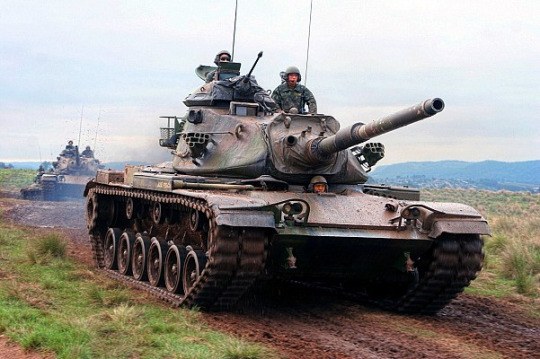
M48 Patton
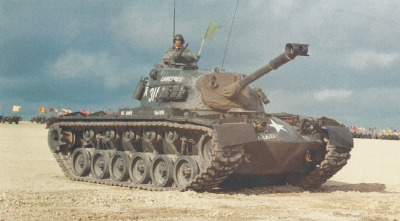
13 notes
·
View notes
Text
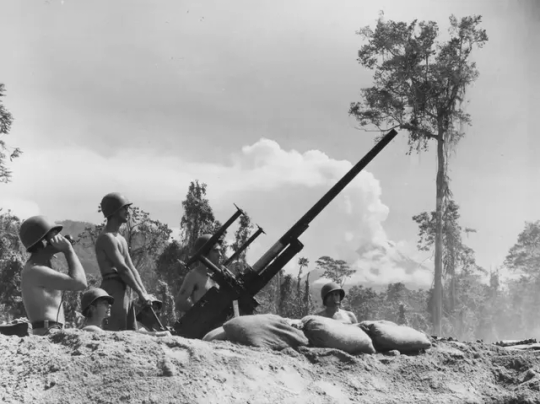
A 40mm antiaircraft gun of the 251st Coast Artillery Regiment, XIV Corps, on Bougainville. In the background is Bagana, an active volcano. 20 January 1944
45 notes
·
View notes
Text

U.S. soldiers operate an armored personnel carrier equipped with a Vulcan antiaircraft gun. American troops used a Vulcan during an enemy ambush on Highway 13 in northern III Corps on 11 January 1969
18 notes
·
View notes
Text
youtube
"Show meeeeee how the gods kill..."
... it's like this. This is how the gods kill.
Some of the sickest Mishima shit you are likely to see, ever, unless you too were forged in the fires of Green Arcade. Crazy Dong Pal (Kazuyer) vs SUPASUPA (Heihachi) casual matches.
Did you need to see jabs flash-ducked into twin pistons. Did you need to see crouch-cancel electrics all over the place. Did you need to see CH df2 into four electrics into screw. Most importantly, do you need to see deeply disturbing timing mixes. Just dudes being bros, dueling with antiaircraft guns at ten paces. Don't flinch.
3 notes
·
View notes